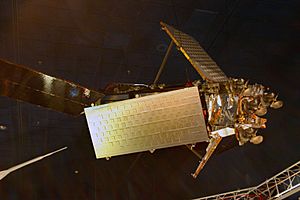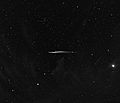Satellite flare facts for kids
A satellite flare is a bright flash of light you can sometimes see in the sky. It happens when sunlight bounces off a man-made satellite and reflects directly back to Earth. Imagine a mirror catching the sun and shining it in your eyes – it's a bit like that, but with a satellite! These flashes are quick and can be super bright, sometimes even 20 times brighter than the planet Venus.
Many satellite flares come from special satellites called Iridium satellites. These satellites are used for things like phone calls and navigation. Most of them fly in a very controlled path around Earth. This means we can often predict exactly when and where a flare will happen! Special Computer programs can use information about the satellite's path to tell observers on Earth when to look up.
Iridium satellites are known for their unusual shape. They have three large antennas, each about the size of a door. These shiny antennas are perfect for reflecting sunlight. When they catch the sun just right, they create those incredibly bright flares. Sometimes, these flashes are so bright you can even see them during the day!
Contents
What is a Satellite Flare?
A satellite flare is a sudden, bright flash of light in the sky. It happens when sunlight hits a shiny part of a satellite and reflects directly towards an observer on Earth. Think of it like a tiny, distant mirror catching the sun's rays and sending them your way.
Why Do Satellites Flare?
Most satellite flares are caused by man-made satellites orbiting Earth. The most famous ones come from Iridium satellites. These satellites have large, flat antennas that are very good at reflecting sunlight. When the angle is just right between the sun, the satellite, and you, you see a bright flash.
Predicting Flares
Because Iridium satellites follow very precise paths in space, their flares are quite predictable. Scientists and skywatchers can use special computer programs to figure out exactly when and where a flare will be visible from a specific location on Earth. This makes it fun to try and spot them!
Flares and Astronomers
While satellite flares are cool to watch, they can sometimes be a problem for astronomers. These bright flashes can briefly disrupt their observations of distant stars and galaxies, especially when they are trying to capture faint light from space.
Images for kids
See also
 In Spanish: Flare de satélite para niños
In Spanish: Flare de satélite para niños










